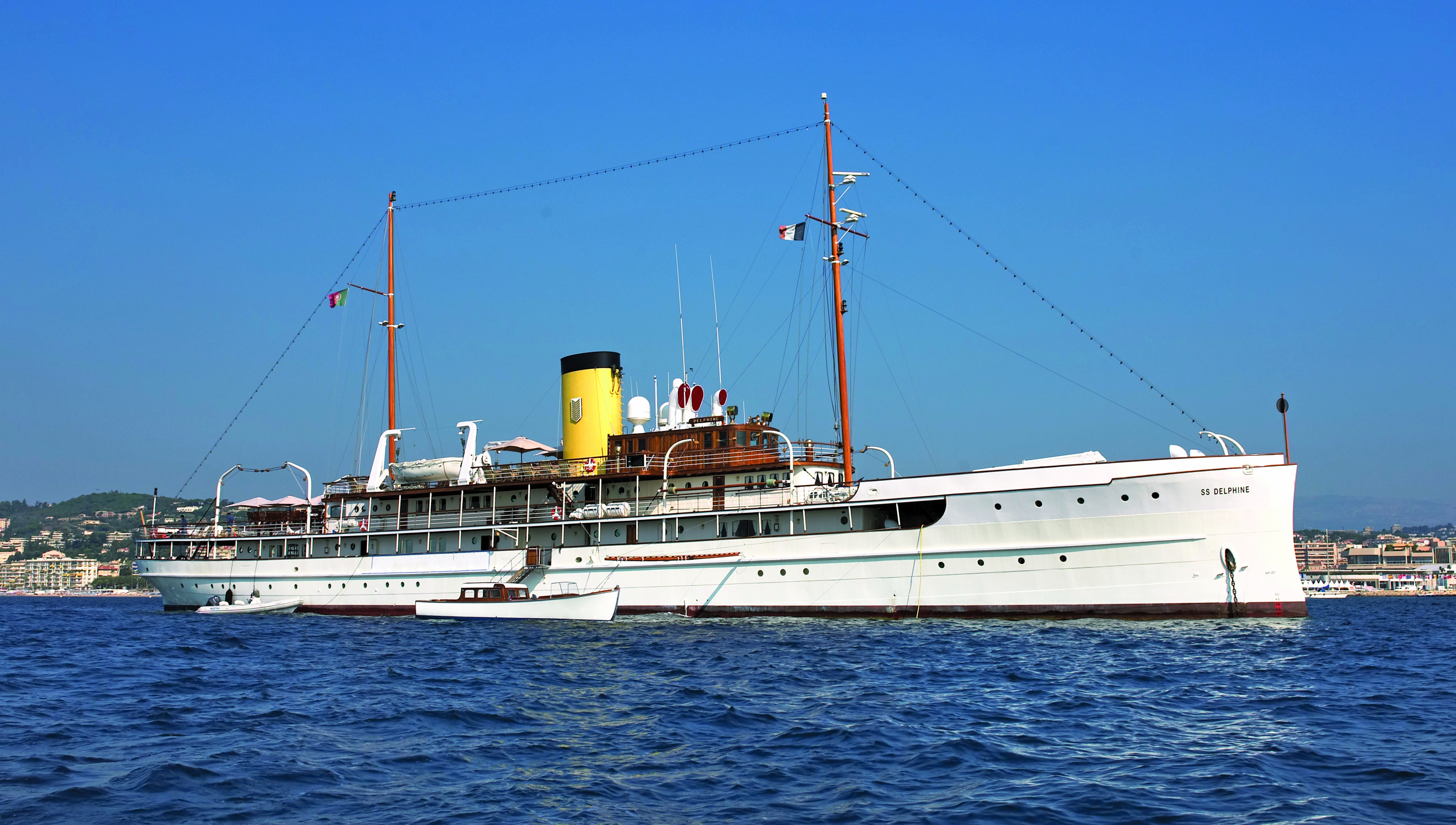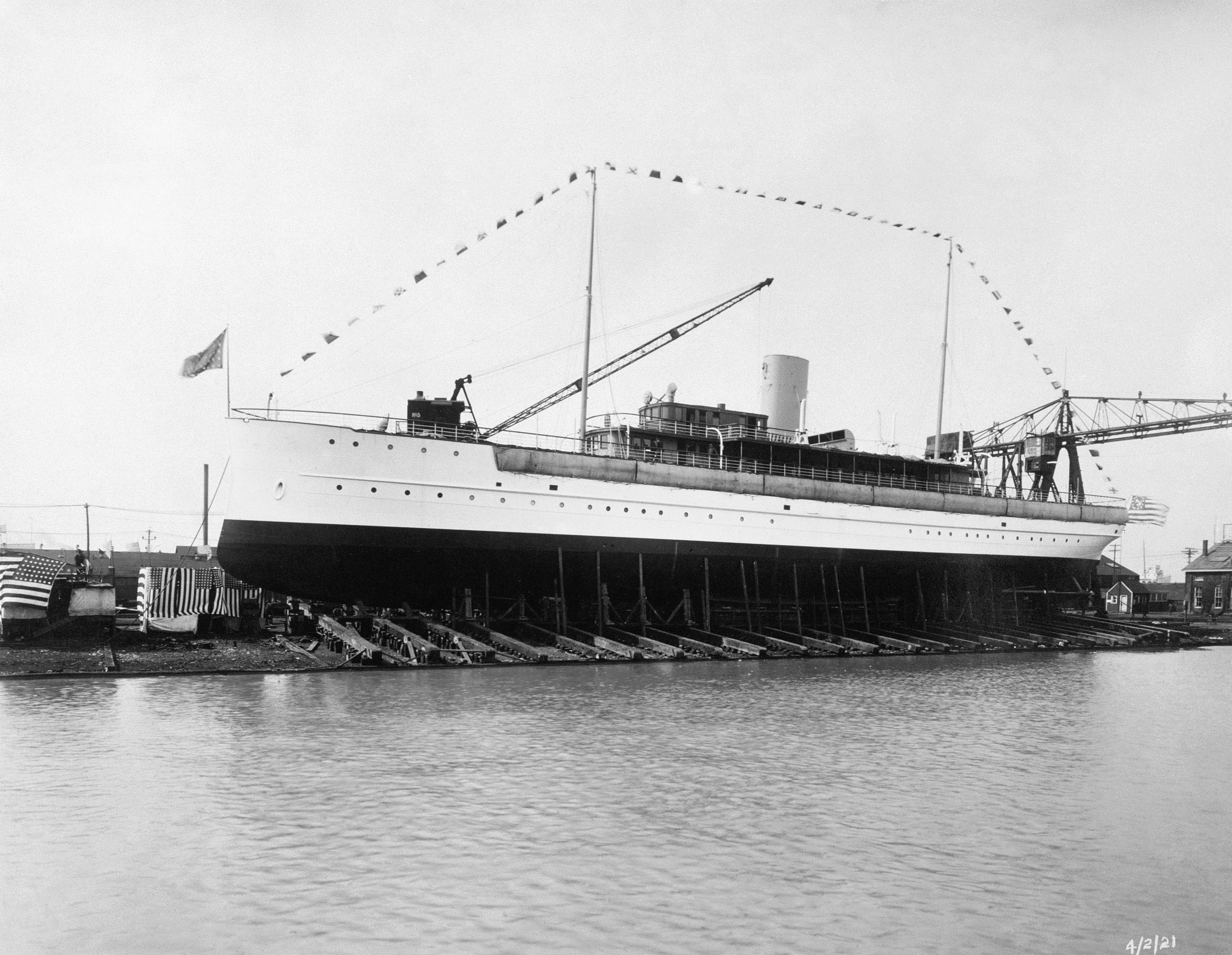
By any measure used, the classic yacht Delphine must be described as extraordinary. Built in an era when high society ruled the yachting waves, the vessel was commissioned by the US automobile magnate Horace Dodge – who was anything but high society. At a time when old money funded the superyachts of the day, no one really accepted that the upstart son of a foundry owner could aspire to the world of luxury afforded by such a magnificent vessel. By Micheal Howorth
Delphine was built at the Great Lakes Engineering Works in Ecorse, Michigan during 1920 at a cost of US$20 million. At 78.5 metres overall, with a displacement of 1,342 tons, she was launched in 1921, and remains today the largest yacht ever built in the US that is still in operation. Her Tiffany-designed interior was lavish, with the formal dining room on the main deck filled with decorations, carvings, wall motifs and the finest of carpets. But rather sadly, Dodge never got to enjoy the luxury he had created. He died in December 1919 having contracted Spanish flu, which in turn gave rise to complications resulting in pneumonia and cirrhosis of the liver. He was just 52 years old at the time of his death.
In 1926, the yacht caught fire in New York and sank. Fortunately, the Dodge family had pockets deeper than the water that engulfed the vessel, and Horace Dodge's widow Anna, was on hand to fund the five-year recovery and rebuild process. Delphine next hit the headlines in 1940 when she reportedly steamed at full speed over rocks in the Great Lakes. There are several reports of her sinking at that time, but subsequent research has proved those to be unfounded. During the Second World War she was requisitioned and pressed into duty as USS Dauntless PG61. Stripped of her lavish interior furnishings, she became the flagship of Admiral Ernest King, Commander in Chief of the US Fleet and Chief of Naval Operations. Legend has it that President Franklin D. Roosevelt, Harry S. Truman, Molotov and Winston Churchill enjoyed the hospitality the yacht had to offer, and it is said that the Yalta Treaty was drawn up in the vessel's ornate smoking room.
With the war over, Anna Dodge was offered the opportunity to buy her lovely yacht back again. After a full refit, only nine hash-marks carved into the woodwork and the navy siren remained as a reminder of Delphine's wartime duty. But, as was the case with so many big yachts around this time, she fell onto hard times after the war years.
Delphine was donated to the Lundeberg Maryland Seamanship School in 1968, and in a fit of national pride they gave her back her navy name of Dauntless. For the next 20 years she was to serve as a training ship for US merchant seamen. Then followed a sorry line of ill-informed but ever hopeful owners. No matter the well-intentioned plans each of them brought to the party, they all failed. Then, in 1997, the Belgian jeans magnate Jacques Bruynooghe fell in love with the concept of reviving a historic yacht that he could enjoy rebuilding and sailing in. That same year, Delphine was towed to Belgium, where she underwent a full restorative rebuild.
Over the six-year refit period, her new Belgian owners invested over €35m bringing Delphine back to the glory days of the Roaring Twenties. Museum archives were scoured for original blueprints to ensure that the engineering and architectural refit precisely matched the original design.

Legend has it that President Franklin D. Roosevelt, Harry S. Truman, Molotov and Winston Churchill enjoyed the hospitality the yacht had to offer, and it is said that the Yalta Treaty was drawn up in the vessel's ornate smoking room
In the early days of the task, there was talk of removing Delphine's old-fashioned steam engines and replacing them with smaller more modern diesel units. Fortunately, common sense prevailed, and despite the expense the owner decided to push forward with the complete rebuild of the original engines. With a nod to modern day ship-handling requirements, he also agreed to the fitting of powerful bow and stern thrusters. Steam engines do not lend well to the start-stop of docking movements, so he wisely chose a powerful hydraulically-driven stern thruster pod that could swivel 360 degrees and provide full in-harbour manoeuvrability.
The decision was made to alter the orlop deck, removing a huge unwanted storage area to create a spa complete with Turkish bath, sauna, gymnasium and even a small hairdressing salon. Pine flooring on the upper decks was found to beyond salvation and was replaced with teak, but the original teak on the main deck was of such high quality and such good repair that it was kept in place. Much of the structure of the yacht was rotten and corroded and was replaced. During the same process her shaft line was modified to allow for the modern day practice of drawing shafts every five years for class surveys.
In 2003 she was finally ready to leave northern Europe and head for warmer climes. With a full ISM system in place and a crew of classic-yacht enthusiasts she arrived in her new homeport of Monaco and entered into her into her new life as a charter yacht.
Each winter saw her moored in Monaco but in the six summers that followed her rebirth, she was in constant demand, pulling crowds of spectators to see her in every port she visited. In 2007 she sailed to Montenegro to take a starring role in the Hollywood production of the movie The Brothers Bloom, starring Rachel Weisz and Adrian Brody.
The financial crisis that engulfed the world proved too much for the owners of the revitalised yacht, not because she was actually uneconomical but because her would-be charterers perceived her to be so. In fact, the complete opposite is probably true in terms of running cost. Where the typical 80 metre motor yacht burns 250 gallons an hour, SS Delphine burns just 66 gallons. Her steam engines have been proved to be every bit as reliable and have the same reaction time as modern diesel engines, and they do so without all the noise and vibrations associated with the motor ship. And by today's standards, the steam engines are very environmentally-friendly. Twin propellers, each 2 metres tall, are powered using 20,000 litres of water converted into superheated vapour pressure using diesel gasoil. This 19th-century steam-driven technology not only cuts costs, but it leaves a significantly lower pollution signature than the modern motor-powered superyacht.
With charters drying up, the owners decided to lay the yacht up, and now the commercially registered vessel is on the market for sale. Besides her beauty and comfort, SS Delphine can still boast of being the largest active steam-driven yacht in existence. All that remains now is for a new owner to be found. One who can love and cherish her for the next 80 or 90 years of her extra ordinary life.
Tags
